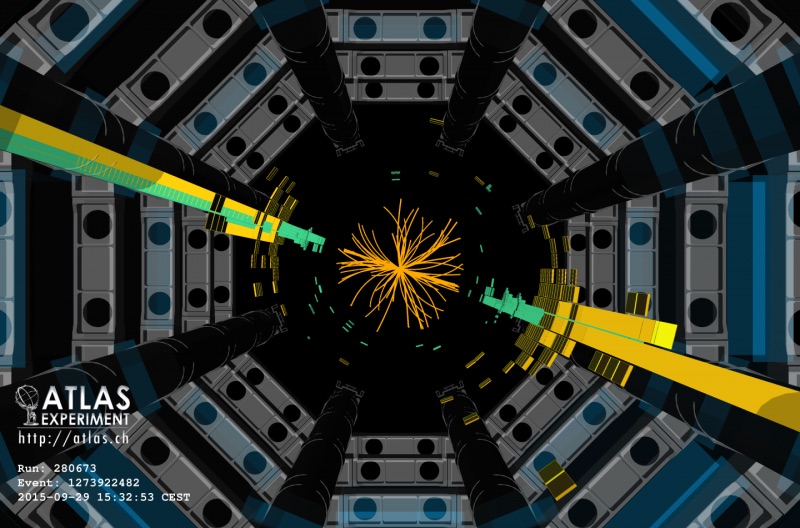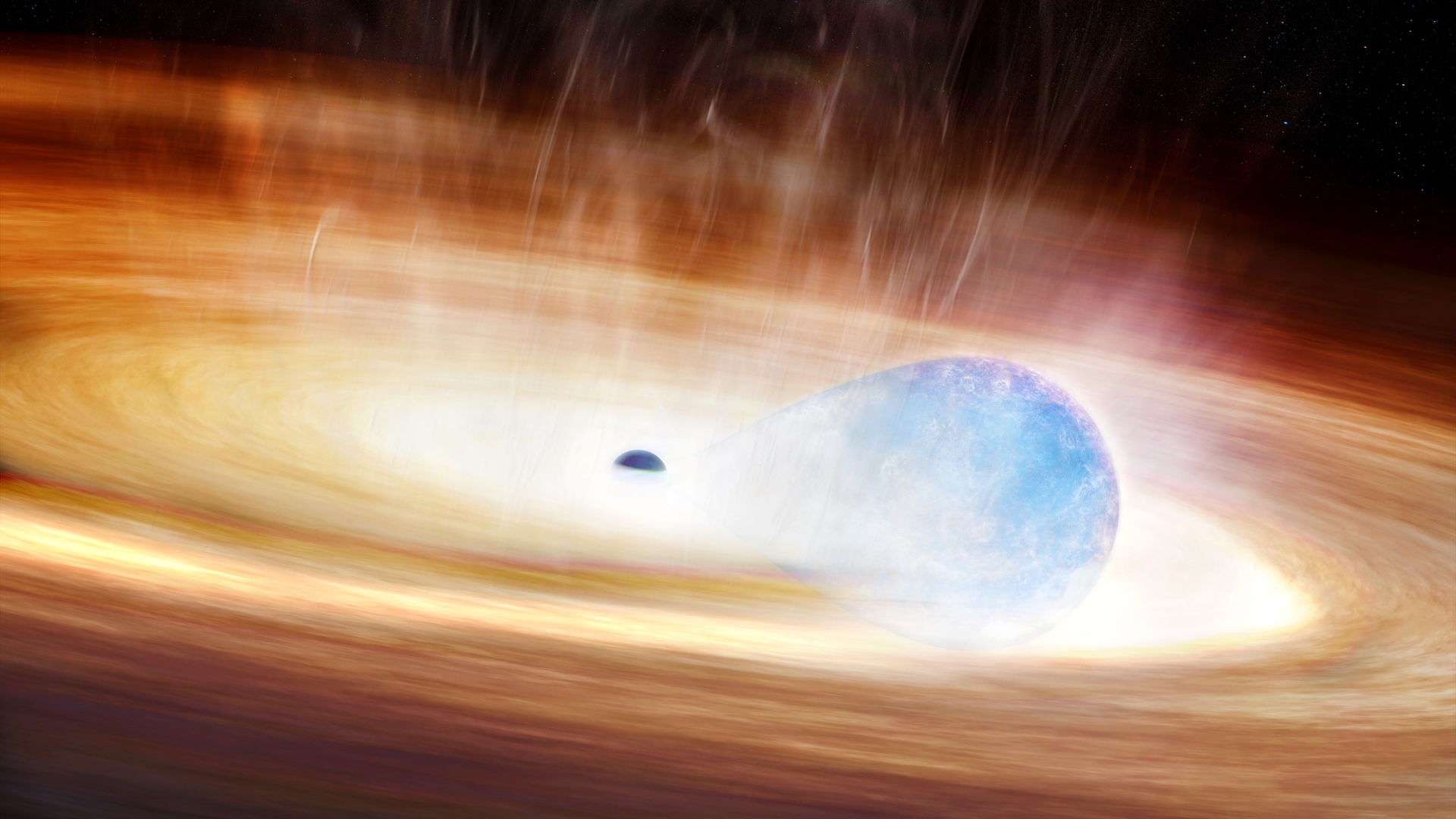Glimpse of Possible New Particle Intrigues Physicists

The biggest particle accelerator in the world might have found a hint of an entirely new fundamental particle — or it might be seeing ghosts.
But even if it turns out to be nothing, particle physicists have written a spate of studies to coincide with the new experimental results, proposing different ideas about what might have been found. Theories in the new research papers range from positing new flavors of the Higgs boson (the particle thought to explain how other particles get their mass) to proposing candidates for dark matter. The studies were posted to the ArXiv, a repository where scientists can get feedback from others in their field ahead of publication or submission to a journal. Nine have been posted so far.
If a new particle or particles turn out to be real, or if dark matter is confirmed, it would mean the reigning model of particle physics, the Standard Model, needs to be extended and possibly replaced. There are a number of candidates, and physicists have long sought Standard Model-breaking physics, because it is clear that the theory is incomplete. At the same time the Standard Model has been hugely successful — it predicted the Higgs boson — and the question is whether physicists are seeing particles predicted by the model or something else entirely. But many are skeptical that this newbie will stand the tests of time. [Beyond Higgs: 5 Other Particles That May Lurk in the Universe]
"I do think the likelihood is now stronger that this will go away than that it will survive," Columbia University mathematician Peter Woit wrote on his blog, Not Even Wrong. "But it would be fantastic if this were true: the nonstandard model physics we've been waiting to see for 40 years, at an energy where the LHC can start to study it."
High-energy crashes
The scientists working on the Large Hadron Collider, operated by CERN, outlined new data this week covering a year of observations from two different detectors inside the atom smasher — ATLAS and CMS. The LHC smashes protons together at near light speed, with energies of 13 trillion electron volts (also expressed as 13 TeV) — higher than any particle accelerator has ever achieved. [See Photos of the World's Largest Atom Smasher (LHC)]
When the protons crash into each other, their energy gets converted to mass, as per Einstein's famous equation, E= mc2. So theoretically, the 13 GeV should get converted to mass in the form of a new particle or particles. If the same old particles are being created, physicists know what to expect from these collisions; it's when they see a spike or anomaly in the energies of the particles that they start looking for something new.
Get the world’s most fascinating discoveries delivered straight to your inbox.
In this case, the detectors picked up a kind of double flash of gamma-ray photons (called a di-photon) at an energy of 750 GeV, which could indicate the presence of a new kind of particle.
Yasunori Nomura at the University of California, Berkeley, theorized that the odd double flash could be explained by a "glueball," a collection of analogues to a gluon. Ordinary gluons carry the strong nuclear force that holds quarks together to form protons and neutrons, among other particles. The glueball would consist of a new kind that only appears at super-high energies. Nomura says his model would be borne out if future LHC runs show phenomena in addition to the gamma rays, which would show that there is a new kind of interaction amongst gluons. But he is cautious. "The event is very exciting, even though it is not yet at the level we can call a discovery," he said.
Others suggest that the anomaly could be a hint of dark matter. One is Mihailo Backovic, a physicist at the Université catholique de Louvain in Belgium. He noted that both detectors picked up the signal at roughly the same energy, about 750 GeV. "I agree that it is still too early to get very excited about the di-photon signal, due to the relatively low signal significance and possible unresolved experimental issues in the form of understanding of backgrounds etc. … but, it is very interesting that both experiments see an excess in roughly the same place."
Is the particle real?
In particle accelerator experiments, one of the measures of a discovery is the number of "events" associated with it — which is one way to say that observers look for how many particles come streaming out of the wreckage of two protons hitting each other.
The rate of these "events" — how often the protons hit each other and produce smaller particles such as gluons and quarks — can also hint at the validity of a finding. The number of events per unit energy (measured in GeV) should describe a smooth curve as the energy goes up, assuming that the physical equations scientists are using are correct. [Images: Follow the Search for the Higgs Boson]
The LHC data shows something tantalizing — a "bump" on the curve of particle events, centered at an energy level of 750 GeV. The bump showed up on both detectors, so at first blush it's less likely to be a fluke.
The problem is that confidence in the data isn't as high as the scientists would like. To clinch a discovery of a new particle, physicists like to have what they call "5-sigma" certainty. Sigma is a measure of how likely it is that what you're seeing is by chance. One sigma would mean that you're pretty likely to see a phenomenon because of a random occurrence — by luck. Five sigma means the odds of something happening by chance are about 1 in 3.5 million.
In this case, the result is 3.9 sigma at best, which is good enough to be intriguing, but not enough to say that anyone has seen a genuinely new particle. It gets worse when the "look elsewhere" effect is taken into account. This means that when you look at a wide range of energies — as this experiment does — there's a certain probability you'll see something, somewhere. When that gets accounted for, the confidence goes down to 1.2 sigma at worst, meaning there's about a 1 in 4 chance that scientists would see something by chance.
That said, many physicists seem confident that future data will show that there is something there.
Nomura said since the events were found by both detectors, the "look elsewhere" effect isn't as important, and the number of events was large enough that it escaped the "error bars" — the amount by which you'd expect to be off, given the precision of the equipment and uncertainty in the measurements.
Yann Mambrini, a physicist at the Université Paris XI, says in his study that the detection might be dark matter, though his model is slightly different from the one proposed by Backovic's team. He said the fact that both detectors picked up something makes the detection important, and that the Higgs wasn't much more certain when it was first discovered. "For the Higgs in December 2011, that was similar, maybe 2 to 3 sigma," he said. The formal announcement of its discovery was made in mid-2012.
Follow Live Science @livescience, Facebook & Google+. Original article on Live Science.

